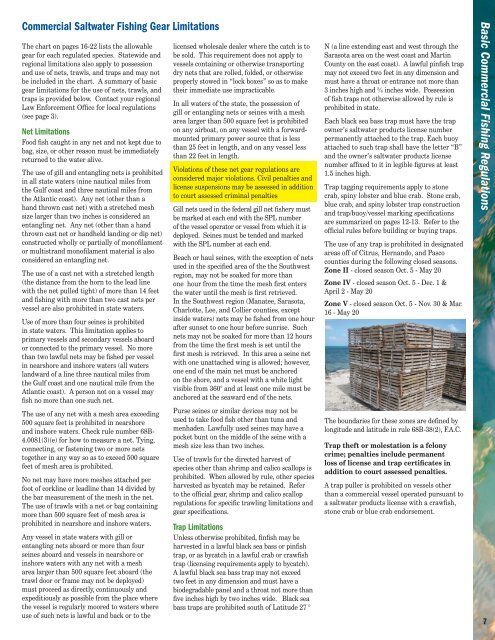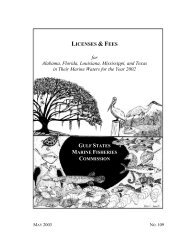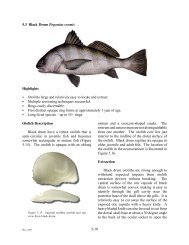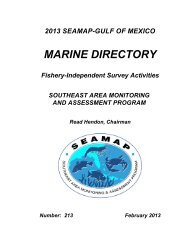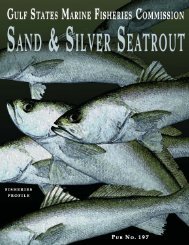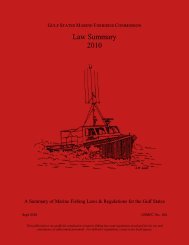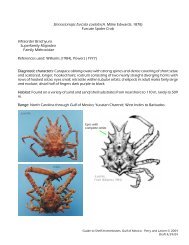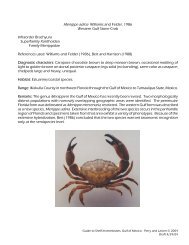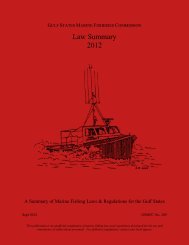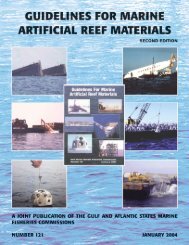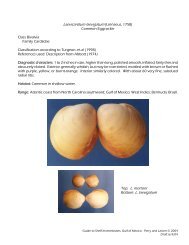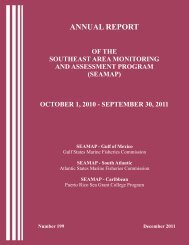Basic Commercial Fishing Regulations - Gulf States Marine ...
Basic Commercial Fishing Regulations - Gulf States Marine ...
Basic Commercial Fishing Regulations - Gulf States Marine ...
You also want an ePaper? Increase the reach of your titles
YUMPU automatically turns print PDFs into web optimized ePapers that Google loves.
<strong>Commercial</strong> Saltwater <strong>Fishing</strong> Gear limitations<br />
The chart on pages 16-22 lists the allowable<br />
gear for each regulated species. Statewide and<br />
regional limitations also apply to possession<br />
and use of nets, trawls, and traps and may not<br />
be included in the chart. A summary of basic<br />
gear limitations for the use of nets, trawls, and<br />
traps is provided below. Contact your regional<br />
Law Enforcement Office for local regulations<br />
(see page 3).<br />
Net limitations<br />
Food fish caught in any net and not kept due to<br />
bag, size, or other reason must be immediately<br />
returned to the water alive.<br />
The use of gill and entangling nets is prohibited<br />
in all state waters (nine nautical miles from<br />
the <strong>Gulf</strong> coast and three nautical miles from<br />
the Atlantic coast). Any net (other than a<br />
hand thrown cast net) with a stretched mesh<br />
size larger than two inches is considered an<br />
entangling net. Any net (other than a hand<br />
thrown cast net or handheld landing or dip net)<br />
constructed wholly or partially of monofilament<br />
or multistrand monofilament material is also<br />
considered an entangling net.<br />
The use of a cast net with a stretched length<br />
(the distance from the horn to the lead line<br />
with the net pulled tight) of more than 14 feet<br />
and fishing with more than two cast nets per<br />
vessel are also prohibited in state waters.<br />
Use of more than four seines is prohibited<br />
in state waters. This limitation applies to<br />
primary vessels and secondary vessels aboard<br />
or connected to the primary vessel. No more<br />
than two lawful nets may be fished per vessel<br />
in nearshore and inshore waters (all waters<br />
landward of a line three nautical miles from<br />
the <strong>Gulf</strong> coast and one nautical mile from the<br />
Atlantic coast). A person not on a vessel may<br />
fish no more than one such net.<br />
The use of any net with a mesh area exceeding<br />
500 square feet is prohibited in nearshore<br />
and inshore waters. Check rule number 68B<br />
4.0081(3)(e) for how to measure a net. Tying,<br />
connecting, or fastening two or more nets<br />
together in any way so as to exceed 500 square<br />
feet of mesh area is prohibited.<br />
No net may have more meshes attached per<br />
foot of corkline or leadline than 14 divided by<br />
the bar measurement of the mesh in the net.<br />
The use of trawls with a net or bag containing<br />
more than 500 square feet of mesh area is<br />
prohibited in nearshore and inshore waters.<br />
Any vessel in state waters with gill or<br />
entangling nets aboard or more than four<br />
seines aboard and vessels in nearshore or<br />
inshore waters with any net with a mesh<br />
area larger than 500 square feet aboard (the<br />
trawl door or frame may not be deployed)<br />
must proceed as directly, continuously and<br />
expeditiously as possible from the place where<br />
the vessel is regularly moored to waters where<br />
use of such nets is lawful and back or to the<br />
licensed wholesale dealer where the catch is to<br />
be sold. This requirement does not apply to<br />
vessels containing or otherwise transporting<br />
dry nets that are rolled, folded, or otherwise<br />
properly stowed in “lock boxes” so as to make<br />
their immediate use impracticable.<br />
In all waters of the state, the possession of<br />
gill or entangling nets or seines with a mesh<br />
area larger than 500 square feet is prohibited<br />
on any airboat, on any vessel with a forwardmounted<br />
primary power source that is less<br />
than 25 feet in length, and on any vessel less<br />
than 22 feet in length.<br />
Violations of these net gear regulations are<br />
considered major violations. Civil penalties and<br />
license suspensions may be assessed in addition<br />
to court assessed criminal penalties<br />
Gill nets used in the federal gill net fishery must<br />
be marked at each end with the SPL number<br />
of the vessel operator or vessel from which it is<br />
deployed. Seines must be tended and marked<br />
with the SPL number at each end.<br />
Beach or haul seines, with the exception of nets<br />
used in the specified area of the the Southwest<br />
region, may not be soaked for more than<br />
one hour from the time the mesh first enters<br />
the water until the mesh is first retrieved.<br />
In the Southwest region (Manatee, Sarasota,<br />
Charlotte, Lee, and Collier counties, except<br />
inside waters) nets may be fished from one hour<br />
after sunset to one hour before sunrise. Such<br />
nets may not be soaked for more than 12 hours<br />
from the time the first mesh is set until the<br />
first mesh is retrieved. In this area a seine net<br />
with one unattached wing is allowed; however,<br />
one end of the main net must be anchored<br />
on the shore, and a vessel with a white light<br />
visible from 360° and at least one mile must be<br />
anchored at the seaward end of the nets.<br />
Purse seines or similar devices may not be<br />
used to take food fish other than tuna and<br />
menhaden. Lawfully used seines may have a<br />
pocket bunt on the middle of the seine with a<br />
mesh size less than two inches.<br />
Use of trawls for the directed harvest of<br />
species other than shrimp and calico scallops is<br />
prohibited. When allowed by rule, other species<br />
harvested as bycatch may be retained. Refer<br />
to the official gear, shrimp and calico scallop<br />
regulations for specific trawling limitations and<br />
gear specifications.<br />
Trap limitations<br />
Unless otherwise prohibited, finfish may be<br />
harvested in a lawful black sea bass or pinfish<br />
trap, or as bycatch in a lawful crab or crawfish<br />
trap (licensing requirements apply to bycatch).<br />
A lawful black sea bass trap may not exceed<br />
two feet in any dimension and must have a<br />
biodegradable panel and a throat not more than<br />
five inches high by two inches wide. Black sea<br />
bass traps are prohibited south of Latitude 27 °<br />
N (a line extending east and west through the<br />
Sarasota area on the west coast and Martin<br />
County on the east coast). A lawful pinfish trap<br />
may not exceed two feet in any dimension and<br />
must have a throat or entrance not more than<br />
3 inches high and ¾ inches wide. Possession<br />
of fish traps not otherwise allowed by rule is<br />
prohibited in state.<br />
Each black sea bass trap must have the trap<br />
owner’s saltwater products license number<br />
permanently attached to the trap. Each buoy<br />
attached to such trap shall have the letter “B”<br />
and the owner’s saltwater products license<br />
number affixed to it in legible figures at least<br />
1.5 inches high.<br />
Trap tagging requirements apply to stone<br />
crab, spiny lobster and blue crab. Stone crab,<br />
blue crab, and spiny lobster trap construction<br />
and trap/buoy/vessel marking specifications<br />
are summarized on pages 12-13. Refer to the<br />
official rules before building or buying traps.<br />
The use of any trap is prohibited in designated<br />
areas off of Citrus, Hernando, and Pasco<br />
counties during the following closed seasons.<br />
Zone II - closed season Oct. 5 - May 20<br />
Zone IV - closed season Oct. 5 - Dec. 1 &<br />
April 2 - May 20<br />
Zone V - closed season Oct. 5 - Nov. 30 & Mar.<br />
16 - May 20<br />
The boundaries for these zones are defined by<br />
longitude and latitude in rule 68B-38(2), F.A.C.<br />
Trap theft or molestation is a felony<br />
crime; penalties include permanent<br />
loss of license and trap certificates in<br />
addition to court assessed penalties.<br />
A trap puller is prohibited on vessels other<br />
than a commercial vessel operated pursuant to<br />
a saltwater products license with a crawfish,<br />
stone crab or blue crab endorsement.<br />
<strong>Basic</strong> <strong>Commercial</strong> <strong>Fishing</strong> <strong>Regulations</strong><br />
7<br />
31


